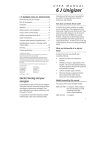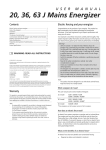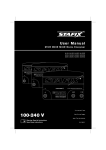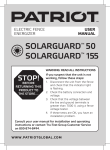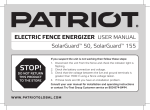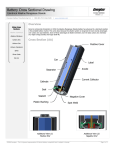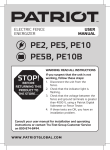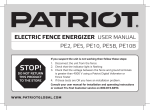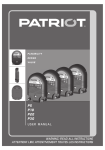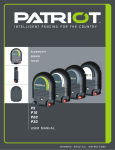Download Tru-Test 2 J User's Manual
Transcript
Contents Models covered by this manual Electric fencing and your energizer..................................2 Installation .....................................................................2 This manual covers various energizer models: 1 J model 1000 / X1 / 401 Operation.......................................................................4 2 J model 2000 / X2 / 402 3 J model 3000 / X3 / 403 Battery selection and management .................................5 Building a permanent electric fence.................................6 Warning! Temporary electric fencing ..............................................8 - USA and Canada - To reduce the risk of electric shock, the energizer’s power adaptor has a polarised plug (one blade is wider than the other). This plug will fit in a polarised outlet one way. If the plug does not fit fully in the outlet, reverse the plug. If it still does not fit, contact a qualified electrician to install the proper outlet. Do not change the plug in any way. - Switch the energizer off before installation or performing any work on the fence. - Read all the safety considerations carefully. See Safety considerations on page 9. - Check your installation to ensure that it complies with all local safety regulations. - Do not connect simultaneously to a fence and to any other device such as a cattle trainer or a poultry trainer. Otherwise, lightning striking your fence will be conducted to all other devices. - Use only the mains/line power adaptor or battery leads supplied with this energizer or a genuine replacement part. Safety considerations......................................................9 Frequently asked questions/Troubleshooting .................10 Servicing ......................................................................11 Product specifications ...................................................11 Warranty ......................................................................11 © 2006 Tru-Test Limited. All product names and brand names in this document are trademarks or registered trademarks of their respective holders. No part of this publication may be photocopied, reproduced, stored in a retrieval system, or transmitted in any form or by any means, electronic, mechanical, photocopying, recording or otherwise without the prior written permission of Tru-Test Limited. Product specifications may change without prior notice. For more information about the Tru-Test range of quality products, see www.tru-test.com. Tru-Test Limited 25 Carbine Road Mt Wellington Auckland 1060 New Zealand Postal address: P O Box 51078 Pakuranga Manukau 2140 New Zealand Note: - 810010 Issue 2 11/06 - This product has been designed for use with electric animal fences. Keep this manual in a handy location. 1 Electric fencing and your energizer What are the benefits of an electric fence? Congratulations on the purchase of your energizer. This product has been constructed using the latest technology and construction techniques. It has been engineered to give superior performance and many years of service. It is important to read these instructions carefully and thoroughly. They contain important safety information and will assist you in ensuring that your electric fencing system gives maximum performance and reliability. An electric fence has many benefits over conventional fencing: Parts of the energizer • Requires less labour and materials to construct. • Flexibility to change or add paddocks when required. The use of strip grazing techniques can allow temporary fencing to be quickly and easily erected or removed. • Controls a broader range of animals. • Minimises damage to expensive livestock when compared with other fencing mechanisms, for example barbed wire. Installation Read all of the safety instructions in this manual carefully before installing the energizer. Selecting a site for the installation Follow these guidelines when selecting a site for your installation. Select a site where: Key to symbols on the energizer Fence earth terminal. Connect the fence earth terminal to the earth system. Fence output terminal. Connect the fence output terminal to the fence. a good earth can be obtained • children and animals cannot interfere with the installation • the installation can be accessed easily Make sure the energizer is installed: • adjacent to the electric fence The energizer should be opened or repaired only by qualified personnel in order to reduce the risk of electric shock. • preferably in the middle of the electric fence system • close to a mains/line power outlet (if using a mains/line supply to power the energizer) Read full instructions before use. • Product Information: Please recycle this product in accordance with the regulations for your country. How does an electric fence work? An electric fence system comprises an energizer and an insulated fence. The energizer puts very short pulses of electricity onto the fence line. These pulses have a high voltage, but are of very short duration (less than 3/10,000ths of a second). However, a shock from an electric fence pulse is very uncomfortable and animals quickly learn to respect electric fences. An electric fence is not only a physical barrier, but is also a strong psychological barrier. 2 • at least 1 m (3') away from and not directly above the battery (if using a battery to power the energizer) If your installation is outside, also make sure that it is: • on firm ground away from flooding • inside a protective fence, if required. Installing the energizer inside Installing the energizer outside The energizer must be installed inside when being powered by the mains/line power supply. The energizer may be installed outside, powered by a battery. Warning! - Do not use a mains/line power extension lead. - Allow 25 mm of clear space around the mains/line power adaptor. To install the energizer inside: 1 2 3 4 5 Select a suitable installation site. See Selecting a site for the installation on page 2. Mount the energizer on a wall. Use the template printed on the back cover of this manual, if required. Connect the Fence earth terminal (green) to the earthing system. Connect the Fence output terminal (red) to the fence. Connect the energizer to the mains/line power using the mains/line power adaptor. Warning! Do not power the energizer with the mains/line power supply if it is being installed outside. To install the energizer outside: 1 2 3 4 5 Select a suitable installation site. See Selecting a site for the installation on page 2. Hang the energizer on a fence wire or mount the energizer on a post. Use the template printed on the back cover of this manual, if required. Connect the Fence earth terminal (green) to the earthing system. Connect the Fence output terminal (red) to the fence. Connect the energizer to the battery using the battery leads. Attach the + (red) clip to the positive terminal of the battery, and the – (black) clip to its negative terminal. Note: If required, this energizer can be used as part of a solar installation, by connecting it to a battery and solar panel(s). For information about solar installations, refer to the product's website (see packaging for details). Note: If the energizer is being installed inside, it may be powered by a battery instead of the mains/line power supply, if required. 3 Operation Select the pulse speed setting using the pulse speed switch. Pulse speed switch Setting Description Off The energizer is off and is not operating. Fast with Battery Test The energizer continues to operate at Fast speed (approximately 1.5 seconds between pulses), but the Indicator lights show the battery level. See Battery test setting on page 5 for an explanation of the Indicator lights. Slow The energizer is operating at Slow speed (approximately 2.5 seconds between pulses). Fast - Day Slow - Night The energizer is operating on Fast setting during the day and Slow setting at night. This setting is for diurnal livestock and is a useful way of conserving battery power when a battery is being used to power the energizer. Slow - Day Fast - Night The energizer is operating on Slow setting during the day and Fast setting at night. This setting is for nocturnal livestock and is a useful way of conserving battery power when a battery is being used to power the energizer. Fast The energizer is operating at Fast speed (approximately 1.5 seconds between pulses). Reading voltage The Indicator lights show the voltage at the output terminals of the energizer. When first connected to the power source, all the Indicator lights illuminate. They then illuminate separately from left to right and back again. This indicates that the energizer is operating normally. After three seconds, the energizer starts pulsing. Each Indicator light segment represents an increment of approximately 1 kV (1000 V) of output voltage. For example, if the first four Indicator light segments are illuminated at each pulse, the output voltage is approximately 4 kV (4000 V). Note: If five Indicator light segments are illuminated, the output voltage may be more than 5 kV (5000 V). After about 20 seconds, the energizer ceases to display the output voltage and one Indicator light segment illuminates each time the energizer pulses. If you see only red lights at each pulse and no green lights, your fence line is very heavily loaded, and you will need to look for faults on the fence line. See Frequently asked questions/Troubleshooting on page 10. 4 Battery test setting When the energizer is connected to a battery and the pulse speed switch is set to 'Fast with Battery Test' ( ) the Indicator lights show the charge level of the battery. The battery test is only relevant when a lead-acid battery is used. Battery-only installation Lights Excellent battery charge level (90-100%): • No action required. Very good battery charge level (70-90%): • No action required. Average battery charge level (40-70%): • Monitor battery charge level. • Recharge the battery to avoid long-term damage to the battery. Poor battery charge level (20-40%): • Monitor battery charge level. • Recharge the battery to avoid long-term damage to the battery. Very poor battery charge level (0-20%): • Recharge the battery immediately. Battery selection and management This section refers exclusively to rechargeable, lead-acid batteries, for example car, tractor, truck, marine or specialist deep-cycle batteries. The size of battery you select will depend on the model of energizer you have and the pulse speed switch position you use most frequently. Refer to Operation on page 4 for an explanation of the function of the pulse speed switch. Battery selection As a guide, the amp hour (Ah) rating of the 12 V lead-acid battery required for each model is shown below. This table is based on a 21 day operating period between battery charging. Although operating time can exceed 21 days, this is likely to cause battery damage and will necessitate frequent replacement of the battery. For best system reliability and long term battery life, the preferred battery and charging regime is to use a deep-cycle, lead-acid battery and to recharge it when it has discharged to about half-way. For more information on testing battery charge level, see Battery test setting above. Energizer Model Pulse speed switch position Current required Battery capacity 1 J model Fast Slow 90 mA 55 mA 90 Ah 55 Ah 2 J model Fast Slow 170 mA 105 mA 170 Ah 105 Ah 3 J model Fast Slow 280 mA 170 mA 280 Ah 170 Ah Warning! A rechargeable 12 V lead-acid battery must be used. 5 Battery management Warning! Batteries contain harmful chemicals and when used incorrectly, may cause injury. Observe the guidelines for battery care, maintenance and safety in this manual and in the documentation supplied with your battery. Battery charging Warning! - Do not attempt to recharge a non-rechargeable battery. - When recharging a battery, ensure that there is adequate ventilation to allow gases to disperse. Regular recharging of the battery is essential. Use a suitably rated battery charger and refer to the battery manufacturer’s recommendations. 1 2 3 4 Disconnect the battery from the energizer. Attach the positive (+) battery charger lead to the positive terminal of the battery, and the negative (–) battery charger lead to the negative terminal on the battery. Insert the battery charger's input power plug into a mains or line socket and turn on the power supply. After the battery is charged, disconnect it from the battery charger before connecting it to the energizer. Caution! Over-charging the battery will reduce its life. Do not exceed the recommendations of the battery manufacturer on recharging the battery from a mains-powered (line-powered) source. Battery care and maintenance • House the battery in a suitably designed battery box, if the battery is likely to be exposed to the weather. • When not in use, keep the battery as fully charged as possible. • Recharge a discharged battery as soon as possible. • Batteries should be stored fully charged and recharged at regular intervals (every 8 weeks) • Inspect the battery regularly to ensure that the electrolyte level does not fall below 12 mm (½") above the surface of the battery plates. • Fill using deionised, distilled or rain water. Do not overfill. Refer to the battery manufacturer’s recommendations for more information. 6 Battery safety • Ensure that the battery is well ventilated when recharging. • Avoid temperatures greater than 50 °C (120 °F). • Ensure the battery is not exposed to naked flame or sparks. Building a permanent electric fence Components of an electric fence An electric fence system comprises the following elements: • An energizer. • An earth system. This comprises a number of metal rods inserted into the ground, which are connected to the Fence earth terminal on the energizer. • Insulated underground cables. Used to connect the energizer to the earth and fence. An insulated fence. Connected to the Fence output • terminal of the energizer. Fences can be made to a variety of designs (see below). Other useful components that can be added: Cut-out switches. Installed at regular intervals, these allow you to isolate sections of the fence for repair. Lightning diverter kit. Used to minimise the damage to your energizer from lightning conducted down the fence line. Typical installation The animal receives a shock when it completes a circuit between the fence and the earth system. The fence below has all live wires and requires conductive soils. These fences are often referred to as 'all-live' or 'earth-return' fences. Alternative installation For poor conductivity soils (dry or sandy), a 'fence-return' or 'earth-wire-return' system is recommended. On these fences the Fence earth terminal is connected directly to at least one of the fence wires. The animal gets maximum shock from touching a live and earth wire at the same time. 15 m (49') spacing with droppers Fence designs Fences can be constructed to suit the type of livestock and materials available. Discuss with your reseller which design best suits your needs. Some suggested fence configurations are below. Wild animals 7 wire, 10 m (33') spacing with droppers Cattle and horses 10-15 m (33-49') spacing, posts only End assemblies Angle stay Suitable for field gate, high-tension strainer. 15-20 m (49-65') spacing with droppers After firmly setting the footed strainer in the ground, dig in the stay block just below ground level, at a distance to ensure the angle stay will be held snugly in position. The stay can be levered into position with a spade. All-live system Sheep, goats, cattle and horses 10 m (33') spacing, posts only Earth-return system 7 Horizontal stay 4 Suitable for field gate, high-tension strainer. Very simple to erect and most suitable as a high tension strainer, excellent in areas where the soil gets very wet or where heavy frost occurs. 5 Using a voltmeter, ensure that the fence voltage is below 2 kV. Check your earth system. Insert the voltmeter's earth probe into the ground at the full extent of the lead, and clip the other lead to the last earth rod. The voltmeter should not read more than 0.3 kV. Anything higher than this indicates that better earthing is required. Either add more earth rods or find a better ground area to drive in the earth rods. Note: When earthing energizers located in dairies, earth at least 20 m (65') away from the dairy using doubleinsulated wire to avoid touching the dairy building or equipment. Installing and testing an earth system Select a suitable site for the earth system. Sites need to be: • At least 10 m (33') from other earth systems (e.g. telephone, mains power or the earth system of another energizer). • Away from stock or other traffic that could interfere with the installation. • At a site that can be easily observed for maintenance. • Ideally at a site that has damp soil (e.g. a shaded or swampy location). Note that the earth does not need to be directly adjacent to the energizer installation. Drive the required number of earth rods into the ground. Use high-voltage, insulated cable and earth clamps to continuously connect the earth rods and the energizer's Fence earth terminal. Make sure the insulation is stripped back to ensure good contact between the wire and the earth rod. The table below specifies the minimum number of 2 m (6'6") earth rods recommended for an earthing system: Energizer Earth rods 1 J model 1 2 J model 2 3 J model 3 Test the earth system, using the following procedure: 1 2 3 8 Turn off the energizer. At least 100 m (330') away from the energizer, short circuit the fence by laying several steel rods or lengths of pipe against the fence. For best results, the fence voltage should be lowered to 2000 V or less. In dry or sandy conditions, it may be necessary to drive the rods up to 300 mm (12") into the earth. Note: It is not acceptable to short-circuit a fence return system to the earth wire of the fence. Turn the energizer back on. Temporary electric fencing A temporary fence can be quickly erected and easily moved allowing the farmer to: • Make smaller paddocks (fields) • Keep herds of animals separated • Ration feed Note: Use more wires for smaller animals and wild animals. Politape should be used when greater visibility is required (e.g. horses). An example of a temporary fence is shown below. Safety considerations This energizer is not intended for use by young children or by infirm persons without supervision. Definition of special terms Young children should be supervised to ensure that they do not play with the energizer. Energizer – An appliance that is intended to periodically deliver voltage impulses to a fence connected to it. Fence – A barrier for animals or for the purpose of security, comprising one or more conductors such as metal wires, rods or rails. Electric fence – A barrier which includes one or more electric conductors, insulated from earth, to which electric pulses are applied by an energizer. Fence circuit – All conductive parts or components within an energizer that are connected or are intended to be connected, galvanically, to the output terminals. Earth electrode – Metal structure that is driven into the ground near an energizer and connected electrically to the Fence earth terminal of the energizer, and that is independent of other earthing arrangements. Connecting lead – An electric conductor, used to connect the energizer to the electric fence or the earth electrode. Electric animal fence – An electric fence used to contain animals within or exclude animals from a particular area. Electric security fence – A fence used for security purposes which comprises an electric fence and a physical barrier electrically isolated from the electric fence. Physical barrier – A barrier not less than 1.5 m (5') high intended to prevent inadvertent contact with the pulsed conductors of the electric fence. Physical barriers are typically constructed from vertical sheeting, rigid vertical bars, rigid mesh, rods or chainwire mesh. Public access area – Any area where persons are protected from inadvertent contact with pulsed conductors by a physical barrier. Pulsed conductors – Conductors which are subjected to high voltage pulses by the energizer. Secure area – The side of an electric security fence where a person may come into contact with the electric fence, without the protection of a physical barrier. Requirements for electric animal fences Electric animal fences and their ancillary equipment shall be installed, operated and maintained in a manner that minimises danger to persons, animals or their surroundings. Warning! Avoid contacting electric fence wires especially with the head, neck or torso. Do not climb over, through or under a multi-wire electric fence. Use a gate or a specially designed crossing point. Electric animal fence constructions that are likely to lead to the entanglement of animals or persons shall be avoided. An electric animal fence shall not be supplied from two separate energizers or from independent fence circuits of the same energizer. For any two separate electric animal fences, each supplied from a separate energizer independently timed, the distance between the wires of the two electric animal fences shall be at least 2.5 m (8'). If this gap is to be closed, this shall be effected by means of electrically nonconductive material or an isolated metal barrier. Barbed wire or razor wire shall not be electrified by an energizer. A non-electrified fence incorporating barbed wire or razor wire may be used to support one or more offset electrified wires of an electric animal fence. The supporting devices for the electrified wires shall be constructed so as to ensure that these wires are positioned at a minimum distance of 150 mm (6") from the vertical plane of the non-electrified wires. The barbed wire and razor wire shall be earthed at regular intervals. Follow our recommendations regarding earthing. See Installing and testing an earth system on page 8. A distance of at least 10 m (33') shall be maintained between the energizer earth electrode and any other earthing system connected parts such as the power supply system protective earth or the telecommunication system earth. Connecting leads that are run inside buildings shall be effectively insulated from the earthed structural parts of the building. This may be achieved by using insulated high voltage cable. Connecting leads that are run underground shall be run in conduit of insulating material or else insulated high voltage cable shall be used. Care must be taken to avoid damage to the connecting leads due to the effects of animal hooves or vehicle wheels sinking into the ground. Connecting leads shall not be installed in the same conduit as the mains supply wiring, communication cables or data cables. Connecting leads and electric animal fence wires shall not cross above overhead power or communication lines. Crossings with overhead power lines shall be avoided wherever possible. If such a crossing cannot be avoided it shall be made underneath the power line and as nearly as possible at right angles to it. 9 If connecting leads and electric animal fence wires are installed near an overhead power line, the clearances shall not be less than those shown in the table below. Minimum clearances from power lines for electric animal fences Power line voltage Clearance ≤1000 V 3 m (10') >1000 V to ≤33,000 V 4 m (13') >33,000 V 8 m (27') If connecting leads and electric animal fence wires are installed near an overhead power line, their height above the ground shall not exceed 3 m (10'). This height applies to either side of the orthogonal projection of the outermost conductors of the power line on the ground surface, for a distance of: • 2 m (6'6") for power lines operating at a nominal voltage not exceeding 1000 V. • 15 m (50') for power lines operating at a nominal voltage exceeding 1000 V. Electric animal fences intended for deterring birds, household pet containment or training animals such as cows need only be supplied from low output energizers to obtain satisfactory and safe performance. In electric animal fences intended for deterring birds from roosting on buildings, no electric fence wire shall be connected to the energizer earth electrode. A warning sign shall be fitted to every point where persons may gain ready access to the conductors. Where an electric animal fence crosses a public pathway, a non-electrified gate shall be incorporated in the electric animal fence at that point or a crossing by means of stiles shall be provided. At any such crossing, the adjacent electrified wires shall carry warning signs. Any part of an electric animal fence that is installed along a public road or pathway shall be identified at frequent intervals by warning signs securely fastened to the fence posts or firmly clamped to the fence wires. • The size of the warning sign shall be at least 100x200 mm (4x8"). • The background colour of both sides of the warning sign shall be yellow. The inscription on the sign shall be black and shall be either: • 10 or the substance of "CAUTION: Electric animal fence". The inscription shall be indelible, inscribed on both sides of the warning sign and have a height of at least 25 mm (1"). Ensure that all mains-operated, ancillary equipment connected to the electric animal fence circuit provides a degree of isolation between the fence circuit and the supply mains equivalent to that provided by the energizer. Protection from the weather shall be provided for the ancillary equipment unless this equipment is certified by the manufacturer as being suitable for use outdoors, and is of a type with a minimum degree of protection IPX4. Frequently asked questions/Troubleshooting What voltage is required to control animals? 4 kV is widely accepted as the recommended minimum voltage to control animals. However, you also require a well constructed fence system to ensure that animals cannot push through electrified wires. The fence voltage is below 4 kV. How do I increase the voltage? Check the energizer. Disconnect the fence wire from the energizer's fence output terminal. Measure the voltage across the energizer terminals with a Fault Finder or Digital Voltmeter. If the voltage is less than 6 kV, the energizer may require servicing. Check the energizer earthing. Use the procedure described in Installing and testing an earth system on page 8. Check the fence system for faults. The most common source of low voltage is faults on the fence line. If the fence, earth and energizer are in good condition and the voltage is still below 4 kV, talk to your nearest reseller. Recent extensions to your fence, a poor fence layout, or soil conditions may be causing inadequate voltage. How do I locate faults? The recommended tool for locating faults is a Fault Finder. This combined voltage and current meter allows you to rapidly locate sources of current leakage. Alternatively, use a Digital Voltmeter. Use cut-out switches to turn off the power to different sections of the farm. If the voltage on the fence increases when a section of the farm is turned off, then investigate that section for possible faults. There are no lights flashing on the energizer. Check the power supply to ensure that the power is switched on. Check the fence system for faults (see above). Check the energizer (see above). If the energizer still does not operate, it may require servicing. Servicing This energizer contains no user serviceable parts. It must be returned to an authorised service centre for repair. This energizer uses Double Insulation, where two systems of insulation are provided instead of grounding. No equipment grounding means is provided in the supply cord of a double-insulated energizer, nor should a means for equipment grounding be added to the energizer. Servicing a double-insulated energizer requires extreme care and knowledge of the system and should only be done by qualified service personnel. Replacement parts for a double-insulated energizer must be identical to the parts they replace. A double-insulated energizer is marked with the words DOUBLE INSULATION or DOUBLE INSULATED and/or the symbol below. Product specifications 1 J model 2 J model 3 J model Power supply 12 V battery, 110-120 V, 60 Hz (115 V models) or 220-240 V, 50 Hz (230 V models) Power consumption using a power adaptor 2.0 W 3.2 W 4.8 W Current consumption using a 12 V, lead-acid battery Fast speed Slow speed 95 mA 60 mA 180 mA 110 mA 290 mA 175 mA Maximum output voltage 9.8 kV 11.0 kV 11.4 kV Maximum output energy 1 J at 500 Ω 2 J at 300 Ω 3 J at 200 Ω Stored energy 1.4 J 2.7 J 4.5 J Warranty This product is warranted against faulty material and workmanship for a period from the date of purchase. If a warranted defect occurs, return this product with proof of purchase to the place of purchase. Details of warranty periods and other terms applying are available at the place of purchase or at www.tru-test.com. Note: - No responsibility is accepted for any accident or damage caused subsequent to any tampering with or modification to or misuse of this product, including (but not limited to) alterations made by anyone other than Tru-Test or its agents. To the maximum extent permitted by law, this warranty is exclusive, personal to you and in lieu of all other warranties, representations or conditions relating to this product (whether express or implied and whenever arising) hether originating by statute, law, trade, custom or otherwise. 11













